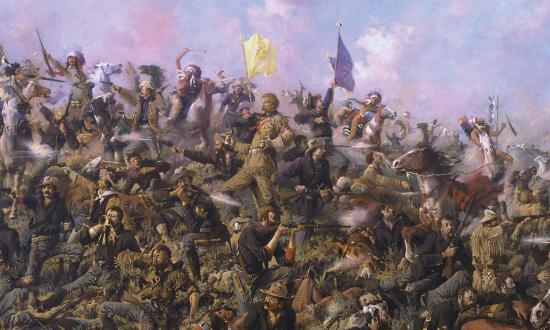Soviet postal authorities and their Russian Federation successors have honored numerous historic and modern warships. Printed in large numbers, these colorful stamps are surprisingly affordable (at least, they were before recent sanctions restricted most trade with Russia).
In 1993, a series of six wide-format 100-ruble stamps were illustrated with images of significant warships and their sponsors or designers.
Tsar and emperor Peter the Great (1672–1725) appears beside the three-masted 58-gun ship-of-the-line Goto Predestinatsiya (God’s Providence). Constructed at the inland shipyard of Voronezh, she was launched in 1700 and served as flagship on the Sea of Azov. As a young man, Peter had learned the trade of shipbuilding by working at a Dutch shipyard under an assumed name.
An 1834 experimental submarine (identified only as podvodnaya lodka, “underwater boat”) is illustrated beside her builder, engineer Karl Andreevich Schilder (1786–1854). Constructed at St. Petersburg, the 16-ton vessel had a crew of eight who operated hand-cranked paddles. Armament included a spar torpedo and triple rocket tubes on either side that could be fired while submerged.
The first Russian screw-propelled warship was the Baltic Fleet steam frigate Arkhimed (named for the ancient Greek inventor Archimedes.) Launched in 1848, she was wrecked in 1850. On the stamp, she appears behind her designer, Engineer General Ivan Afanasyevich Amosov (1800–78.)
Launched in 1915, the submarine Bars (Leopard) was the first in a class of 24 that served the Baltic and Black Sea Fleets in World War I. She appears on the stamp with her designer, Ivan Grigoryevich Bubnov (1872–1919), who died in a typhoid epidemic in St. Petersburg.
Launched in 1928, the submarine Dekabrist was first in a class of six. She was lost in an accident in 1940 while training near Murmansk, but other boats of the class served in World War II, and one, the Narodovolets, survives as a museum ship at St. Petersburg. The designer, naval engineer Boris Mikhailovich Malinin (1889–1949,) went on to design three more Soviet diesel-electric submarine classes.
Six Kirov-class cruisers were the first large warships built in the 1930s for the Soviet Navy. Engineer Anatoly Ioasafovich Maslov (1884–1968) based his design on the Italian Condottieri class, replacing the typical light cruiser armament of eight 6-inch guns with 7.1-inch guns in three triple turrets.
In commemoration of the Russian Navy’s 300th anniversary in 1996, seven stamps and a souvenir sheet illustrating historic warships were issued.
A drawing of the Baltic Fleet’s 66-gun ship-of-the-line Evstafy (named for the 2nd-century Roman martyr Saint Eustace), launched in 1762, appears on the 750-ruble stamp.
A 1,000-ruble stamp depicts the 1894 battleship Petropavlovsk, sunk in April 1904 by a mine off Port Arthur during the Russo-Japanese War, with the loss of 679 men, including Vice Admiral Stepan Osipovich Makarov.
Another 1,000-ruble stamp shows the destroyer Novik, the world’s fastest warship (at 37.3 knots) when she entered service in 1913. The 52 Novik-class ships were the first destroyers fueled by oil rather than coal.
A dark blue monochrome drawing of the Azov fleet galley Printsipium, built at Voronezh in 1696, appears on a 1,000-ruble stamp. Oared galleys continued to serve on the calm waters of the Baltic and Sea of Azov long after most navies had abandoned them.
A 1,000-ruble stamp depicts the troubled aircraft carrier (the Russian designation is “heavy aviation cruiser”) Admiral Kuznetsov. Originally named the Riga, she was launched as the Leonid Brezhnev, embarked on sea trials as the Tbilisi, and finally named to honor World War II Fleet Admiral Nikolai Gerasimovich Kuznetsov (1904–74).
The unique destroyer Tashkent (aka “Project 20”) illustrates a 1,500-ruble stamp. Built in Italy in 1937 for the Soviet Black Sea Fleet, she was remarkably fast, making 42.7 knots on trials. She participated in the sieges of Sevastopol and Odessa before being sunk by Axis bombs in 1942.
The Stalinets-class submarine S-13 illustrates a 1,500-ruble stamp. Launched in 1939, she was the top-scoring Soviet boat of World War II. On 30 January 1945, S-13 sank the German passenger liner Wilhelm Gustloff in the Baltic, with an estimated loss of 9,000 lives. This is considered the worst disaster in maritime history.
Two additional warships appear on a four-stamp souvenir sheet commemorating the Russian Navy’s 300th anniversary.
The 74-gun ship-of-the-line Azov, built in 1824, was flagship of the Russian Mediterranean Squadron at the Battle of Navarino on 20 October 1827, where an allied fleet decisively defeated the Ottoman Turks in the Greek War of Independence. (See “Twilight of the Oak and Canvas Gods,” October 2021, p. 9.) Heavily damaged, the Azov was broken up in 1831.
Identified only as “Heavy Atomic Underwater Cruiser,” a Typhoon-class (Project 941) nuclear ballistic-missile submarine appears on a final 1,000-ruble stamp. Six of these enormous boats were completed, beginning in 1981. At 48,000 tons submerged, they were the world’s largest submarines. At this writing, one, the Dmitriy Donskoy (TK-208), remains in service with the Northern Fleet.




















